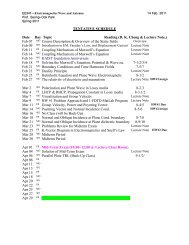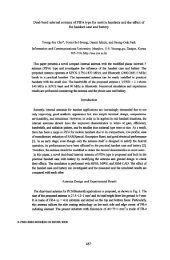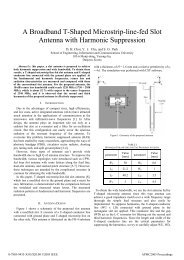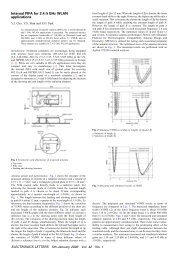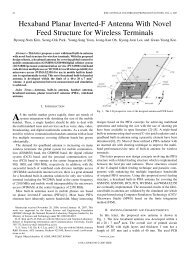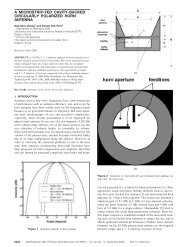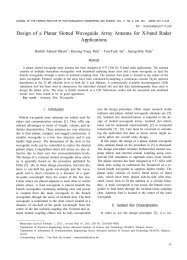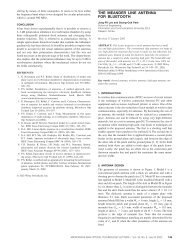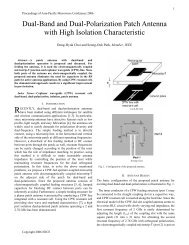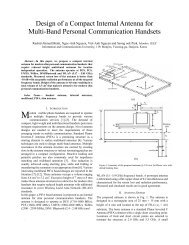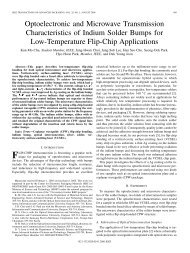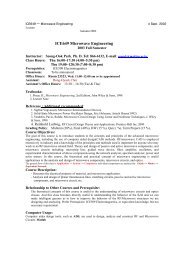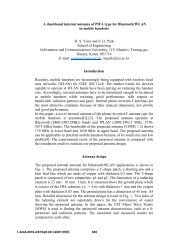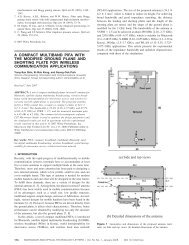A Miniature UWB Planar Monopole Antenna with 5 - Microwave and ...
A Miniature UWB Planar Monopole Antenna with 5 - Microwave and ...
A Miniature UWB Planar Monopole Antenna with 5 - Microwave and ...
Create successful ePaper yourself
Turn your PDF publications into a flip-book with our unique Google optimized e-Paper software.
(a)<br />
Fig. 1. Geometry of the proposed antenna<br />
(a) Top view (b) Side view (c) Bottom view<br />
on the b<strong>and</strong>width of the proposed antenna. This is<br />
because stronger current distributions – more than any<br />
other region of the radiation element – exist in the<br />
vicinity of point A on the radiation element. Therefore,<br />
that region plays an important role in impedance<br />
matching. In other word, it is a sensitive part of the<br />
tuning region. The optimized value of s h is selected as 2.2<br />
mm, as shown in Fig. 2(a). On the other h<strong>and</strong>, the<br />
b<strong>and</strong>width is further widened when the slit width (s w ) is<br />
narrower, as shown in Fig. 2(b). Nevertheless, the slit<br />
width of s w is determined at 0.2 mm due to the<br />
manufacturing tolerance. In Fig. 1(c), the modified<br />
ground plane is shown on the bottom side of the substrate.<br />
Both side edges of the ground plane were constructed in<br />
a circular shape which consists of a quadrant <strong>with</strong> a<br />
radius of 7 mm in order to reduce the beam tilting <strong>and</strong> to<br />
obtain wide b<strong>and</strong>width [10],[11]. The radiation pattern of<br />
the monopole antenna is not the same as that of the<br />
dipole antenna because it does not an infinite ground<br />
plane. The size of ground plane is finite in actual usage.<br />
The direction of maximum radiation tilts somewhat<br />
upwards from the horizontal plane due to the finite<br />
ground plane. To reduce this beam tilting, the ground<br />
plane of the proposed antenna is designed to have a<br />
circular shape rather than a rectangular shape. To achieve<br />
wider b<strong>and</strong>width, some upper part of the ground plane is<br />
extended [9]. As shown in Fig. 3(a), the small changes in<br />
(b)<br />
Fig. 2. Simulated VSWR as a result of the parameters of each<br />
slit<br />
(a) Variations of s h <strong>with</strong> a fixed value of s w = 0.2 mm<br />
(b) Variations of s w <strong>with</strong> a fixed value of s h = 2.2 mm<br />
the height of the extended ground plane (g h ) has an effect<br />
on the b<strong>and</strong>width of the proposed antenna. But the width<br />
changes have a negligible influence, as shown in Fig.<br />
3(b). The reason is that the extended ground plane is<br />
located in the opposite side of the sensitive point where<br />
the current distribution is the strongest. As in the<br />
preceding explanation, the changes of height (g h ) of the<br />
extended ground plane have significant effects on<br />
impedance matching. Additionally, the extended ground<br />
plane reinforces capacitance. The reinforced capacitance<br />
that results from the extended ground plane cancels the<br />
inductance of the antenna [9]. However, the width<br />
variation of the extended ground plane does not affect the<br />
b<strong>and</strong>width quiet as much because although the width is<br />
wider, the geometry of its sensitive area is almost<br />
constant. The values of g h <strong>and</strong> g w are optimized at 8 mm<br />
<strong>and</strong> 11 mm, respectively. Fig. 4 shows that the U-shaped<br />
slot plays a role in the b<strong>and</strong>-rejection filter. It is<br />
necessary to notch out portions of the b<strong>and</strong> to avoid<br />
interference <strong>with</strong> existing wireless networking<br />
technologies such as IEEE 802.11a. The ability to<br />
provide this function in the antenna can relax the<br />
requirements imposed upon the filtering electronics<br />
<strong>with</strong>in the wireless device. In Fig. 4 (a) <strong>and</strong> (b), there are<br />
similar variations of in each graph. This means that the<br />
resonant frequency of a notched b<strong>and</strong> is determined by



